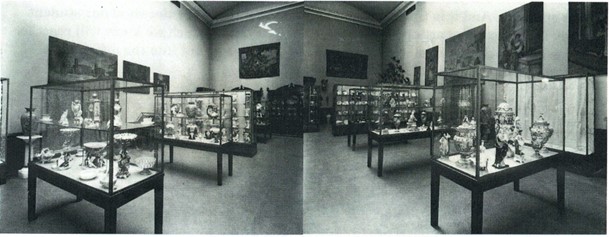Housed within the Vanderbilt University Museum of Art, the Sullivan Memorial Collection offers a vivid testament to the profound influence of philanthropy on educational and cultural institutions. This significant collection was established through the generous contributions of New York City-based philanthropists, Mary Mildred Sullivan and her son, George Hammond Sullivan. Spanning over three decades starting in 1916, their philanthropic efforts not only augmented Vanderbilt University’s cultural resources but also had a lasting impact on art education across the region.
Historical Context and Philanthropic Vision
The relationship between the Sullivans and what was then George Peabody College for Teachers—a precursor to the collection’s integration into Vanderbilt University—was underpinned by a shared commitment to educational excellence and accessibility. This partnership was facilitated by the Algernon Sydney Sullivan Foundation, an organization dedicated to humanitarian efforts and educational support, reflecting the values and legacy of Algernon Sydney Sullivan, Mary Mildred’s husband. Today, the connection between the Foundation and Vanderbilt continues, guided by a mutual dedication to celebrating service, leadership, and integrity.
The collection began with an initial donation of reproductive prints and illustrations to the George Peabody College for Teachers, aimed at enhancing the school’s art courses. At a time when access to high-quality art reproductions was both limited and costly, these gifts were transformative. Dr. Courtney Wilder, curator of the Sullivan Collection, emphasized the significance of these early contributions: “It is a pleasure to give things where one knows they will really be of use,” reflecting George Sullivan’s satisfaction, as expressed in his correspondence with Earl Warner, a Peabody art professor, in 1917.
Foundational Impact on Art Education
The early contributions of the Sullivan Memorial Collection to George Peabody College for Teachers marked a pivotal shift in the role of visual arts in educational curricula. As the collection began with the generous donation of reproductive prints and illustrations, it immediately addressed a significant gap in the educational resources available to art educators and students at the time. These initial gifts, strategic and thoughtful in their selection, were more than just supplementary materials; they were fundamental tools that transformed the teaching and appreciation of art at the College.
Enhancing Classroom Resources and Instruction
The inclusion of high-quality reproductions allowed faculty at Peabody College to offer a more immersive and comprehensive art education. Prior to these donations, students had limited exposure to diverse artistic works, mainly learning through textbooks that lacked visual representation. With the Sullivan Collection, students could study detailed reproductions of masterpieces, understanding nuances of form, technique, and historical context that were previously inaccessible.
Art professor George S. Dutch noted the immediate impact of these resources. By integrating the artworks into the curriculum, Dutch was able to design courses that were more engaging and informative, thereby significantly increasing student enrollment in art classes. This surge in interest was not just a testament to the growing appeal of the arts but also reflected the enhanced quality of education that could be delivered with adequate resources.
Cultivating a Deeper Appreciation of Art
The Sullivan Collection did more than just enhance educational content; it fostered a deep, lasting appreciation of art among future educators. By exposing students to a variety of artistic expressions and styles, the collection helped cultivate a sophisticated understanding of the visual arts. This education was not limited to the aesthetics of art; it also included an exploration of art’s cultural and historical significance, providing students with a holistic view of the arts as a fundamental aspect of human experience and expression.
Professor Dutch’s courses, for instance, emphasized the importance of art appreciation as a foundation for classroom teaching. This approach not only prepared students to incorporate art into their future teaching practices but also encouraged them to appreciate art as a crucial element of general education and personal development.
Impact on Future Educators and Broader Educational Goals
The transformative effect of the Sullivan Collection extended beyond individual student experiences. The future educators trained at Peabody College carried with them an enriched understanding and appreciation of art, which they passed on to their own students across the South. This multiplier effect was significant in spreading the values of comprehensive art education far beyond the confines of the College.
Moreover, the presence of the Sullivan Collection at Peabody College encouraged a broader pedagogical shift toward integrating art into the education system. This shift was reflected in the development of new teaching methods and educational materials that leveraged visual arts as a tool for enhancing critical thinking, creative expression, and cultural literacy among students.
Expansion and Public Engagement
As the Sullivan Memorial Collection matured and expanded, its reach extended into the community at large, enhancing public engagement with the arts. The inauguration of a dedicated gallery space in 1919 on the Peabody campus marked a significant development, both for the college and the city of Nashville. This new gallery, enthusiastically reported by The Tennessean in October of that year, was more than just an addition to the campus; it was a cultural milestone for a city with few other museum resources at the time. At a time when access to art exhibitions and museums was limited, the gallery served as a beacon for art appreciation and education in the region. The space not only housed the growing collection but also became a center for cultural activities and events that drew in the public, offering them direct exposure to both national and international works of art. This accessibility played a crucial role in cultivating a more informed and appreciative audience for the arts within the local community.
Curatorial Vision of George Sullivan
George Sullivan’s role as a curator was pivotal in shaping the trajectory of the collection. His involvement went beyond mere acquisition; he was deeply engaged in determining how the artworks could be utilized to enhance education and foster a broader cultural appreciation. Sullivan’s curatorial strategy was grounded in the belief that art should be accessible and instructive. He focused on acquiring pieces that not only held aesthetic value but also offered educational utility, particularly for students and faculty at Peabody who were future educators.
This approach was instrumental in ensuring that the collection supported a wide range of educational activities. Exhibits were often designed to complement academic curricula, providing students with practical examples that reinforced their classroom learning. Furthermore, Sullivan’s choices reflected a nuanced understanding of art as a multidimensional resource that could inspire, educate, and provoke thoughtful discussion among diverse audiences.
Public Programs and Educational Outreach
The gallery also spearheaded a variety of public programs and educational outreach efforts. Lectures, workshops, and guided tours became regular features, drawing in visitors from across the region and enhancing the educational impact of the collection. These programs were tailored to diverse audiences, including K-12 students, college students, educators, and the general public, ensuring that each group could find relevance and value in the collection.
Additionally, the gallery collaborated with local schools and community organizations to develop tailored educational programs. These partnerships helped to extend the reach of the collection’s educational impact, making art more accessible to underserved communities and fostering a broader cultural literacy.
Legacy of Engagement and Accessibility
The expansion of the Sullivan Collection and the establishment of the gallery on Peabody’s campus were more than just enhancements to the college’s infrastructure; they were transformative developments that significantly influenced Nashville’s cultural and educational landscape. The strategies implemented by George Sullivan and the continued efforts of the college ensured that the collection remained a vital public resource, dedicated to enriching the community’s engagement with the arts.
Today, the legacy of this expansion and engagement continues to influence how the collection is perceived and utilized. It remains a cornerstone of Vanderbilt University’s commitment to public service and educational excellence, reflecting an enduring legacy that bridges the past with the future of art education and public cultural engagement.
The collection remains a cornerstone of the Vanderbilt University Museum of Art’s offerings. It has been thoughtfully integrated into a broader educational and cultural context, benefiting not only students and academics but also the wider public. The ongoing efforts to catalog and digitize the collection have further increased its accessibility and educational potential.
In essence, the Sullivan Memorial Collection at Vanderbilt University embodies the transformative potential of combining philanthropy with education and the arts. It stands as a lasting tribute to the Sullivan family’s commitment to enhancing educational resources and promoting cultural enrichment. Through ongoing exhibitions and research, the collection continues to inspire and educate, preserving the legacy of philanthropy and service championed by the Sullivans and the Algernon Sydney Sullivan Foundation. This enduring partnership underscores a shared vision of nurturing communities that value education, art, and the betterment of society.
References:
Wilder, C. (n.d.). The Sullivan Memorial Speech Collection at the Vanderbilt University Museum of Art: An evolving history.
Back to all News items.


